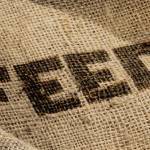Researchers Discuss Nutrition Problems in Horses

Several professionals at Kentucky Equine Research (KER) recently gave a presentation to some of the country’s top feed manufacturers to shed light on common problems in equine nutrition from the standpoints of both veterinary care and feed management. Participating in the presentation were Bryan Waldridge, D.V.M., Peter Huntington, B.V.Sc., Kathleen Crandell, Ph.D., and Clarissa Brown-Douglas, Ph.D.
Malnutrition/starvation Many causes including neglect, poor feed quality, dental problems, parasite load, disease, or metabolic upsets. Prognosis is not good for horses that have been recumbent for three days or have lost nearly half their body weight. In spite of a caretaker’s desire to see the horse regain weight, refeeding must be done carefully, beginning very gradually with frequent, tiny offerings of hay (handful every few hours up to 1% of their body weight in feed) in the first two to three days. Work up to feeding larger amounts of hay. Concentrates should not be given at first. Refeeding the undernourished/malnourished horse requires a different program from that designed to refeed a starved horse, and offering too much food too soon in either situation can be extremely detrimental.
Hyperkalemic periodic paralysis (HYPP) Genetic disease common in Quarter Horses and related breeds. Characterized by muscle trembling and weakness, may be triggered by stress. Treated by feeding a low-potassium diet and following a program of regular exercise.
Polysaccharide storage myopathy (PSSM) Characterized by muscle stiffness and cramping after mild exertion. Diagnosed by muscle biopsy and a genetic test for one form of PSSM. Treatment includes low-starch, high-fat diet. Turnout and regular exercise are recommended.
Nutritional secondary hyperparathyroidism Characterized by skeletal changes due to skewed dietary calcium/phosphorus ratio. Decrease feeds with a high phosphorus content and supplement with calcium.
Insulin resistance (IR) Several conditions linked to IR including obesity, Cushing’s disease, and metabolic syndrome. Treatment involves weight loss and increased exercise as tolerated. Use of low-starch feed and hay is recommended. Dietary supplementation may be necessary to provide necessary nutrients.
Equine motor neuron disease/equine degenerative myelopathy/neuroaxonal dystrophy Group of diseases resulting from low supply or low utilization of vitamin E. Nerve development and function are affected. Some breeds have a genetic predisposition. Supplementation with vitamin E is helpful, as is turning the affected horse out on green pasture, as fresh grass contains a high level of vitamin E. Prognosis varies by breed, severity, and specific problem.
Poor-doing foal/poor appetite Horses that are poor keepers may have ulcers, dental problems, low herd status (can’t access feed), infections, chronic diarrhea, fatigue from high levels of exercise, or other causes of stress. Treatment involves finding and correcting the specific problem for each horse. Feeding small frequent meals with palatable, high-quality feed and hay is recommended after the causative problem has been identified and corrected.
Developmental orthopedic disease (DOD) The term describes a group of diseases that affect the skeletal development of young horses, decreasing their sale value and impacting their ability to train and perform. Multifactorial causes including genetics, trauma, nutrient amounts and balances, environment, conformation, and growth rate. Prognosis varies by type of problem. In some cases, damage is irreversible by the time it is detected, while other conditions are self-correcting without intervention. In many conditions, reducing energy intake and body weight while maintaining adequate protein and mineral intake is helpful.
Food allergies Signs include hives, itching, scratching, and hair loss, though each of these signs can have other causes. Intradermal and serum allergy testing are not foolproof diagnostic aids. Carefully controlled elimination diets may be helpful in identifying the particular allergen to which the horse is reacting.








